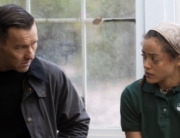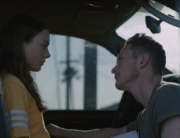Drake Doremus’s melodrama Breathe In dissects the hidden dynamic within a seemingly perfect, middle-class family when a seductive English exchange student comes into their lives. The film opens with a family of three being photographed in the sun, just outside their sizable country home. The trio’s matron, Megan Reynolds (played by Amy Ryan), passive-aggressively directs the photographers as to how she would like to be portrayed for the family newsletter. “Is the swing set in the shot? I don’t want that in it at all.” They could only be in Connecticut.
This is the only scene in which Megan’s husband, Keith (Guy Pearce), seems content with his life. Now a piano teacher at the local high school, Keith spends his free time performing cello with the local orchestra, auditioning for symphony chairs in New York, and staring longingly at the decades-old photos of his band and expired city life. His day-to-day existence is far more a reflection of Megan’s ideals than his own, and Megan is too preoccupied collecting cookie jars and scrapbooking to attend to her husband’s mid-life crisis with any considerate attention.
Keith and Megan’s daughter, Lauren (Mackenzie Davis), completes the apparently perfect Reynolds trio. Nearing her senior year of high school, she excels on the swim team as well as on the social ladder of teenage hierarchies. As the family prepares for the new school year, Megan reminds Keith and Lauren that Sophie (Felicity Jones) will be arriving from London in the next couple of days. Given the sweeping orchestral score that accompanies the entire film, along with heavy close-ups of a pensive Guy Pearce, the audience has no trouble guessing what will happen next.
Like most melodramas, Breathe In is predictable, but to a flawed level that momentarily convinced me of precognition. This is mostly due to the film’s use of cliché, which isn’t brazenly bad, but certainly crosses the line from solid character development to caricature development. Keith’s wife and daughter are both blond, wholesome, and look as though they have sauntered off the pages of a Banana Republic catalog. So naturally Sophie must be brunette, wear all black, and read tragic literature.
Contrasted to Lauren’s bubbly, juvenile demeanor, Sophie is reticent and mature, preferring the pages of Jane Eyre to nights of binge drinking, and Keith to boys her own age. She harbors secrets even the audience isn’t privy to, and she and Keith share an immediate chemistry. As their intimacy grows, Megan and Lauren become ultimate victims of their affair.
There are a host of issues with this film. The first of which is its fable-like predictability, as mentioned above. Secondly, its use of music is heavy-handed and downright corny. In one scene, Sophie attends Keith’s piano class, during which she is told to play a little something to introduce herself. Starting with a soft, casual classical piece, she rages into a full-blown Chopin frenzy, banging passionately on the ivories. Keith stands in amazement, while the audience tries to stifle an eye roll.
Then, of course, there is the surge of cheesy club music that scores the New York montage in which Sophie sees the city for the first time with a classmate. There is also a notable continuity issue in a scene when Lauren, too drunk to drive home, must hand over the keys of her new car to Sophie. Though she’s never been in the States before, Sophie seems oddly comfortable driving on the right side of the road, despite her English origin. In this spirit of inexplicability, the film never discloses how the family can afford a home in suburban Connecticut and a new car for their daughter on a school teacher’s salary and whatever income Megan provides from her seemingly non-existent career.
Regardless of these issues, I must admit that I did enjoy watching it… a lot actually. It does have a proximity to a Lifetime Original Movie, but it is attention-grabbing and plays into a sexual taboo that has intrigued audiences for a long time. Aside from that, there is a particularly enjoyable cameo from Kyle MacLachlan, and sometimes that’s all I need to get on board. Both Pearce and Jones are convincing in their roles, and the flaws of the film are not their fault. Most are due to the script and the post-production (i.e., the music). I suspect if you enjoy sentimental films such as The Notebook, then perhaps you should find time for Breathe In.






Leave A Comment